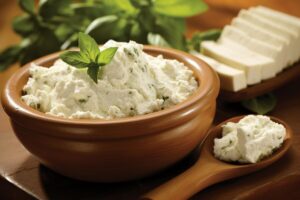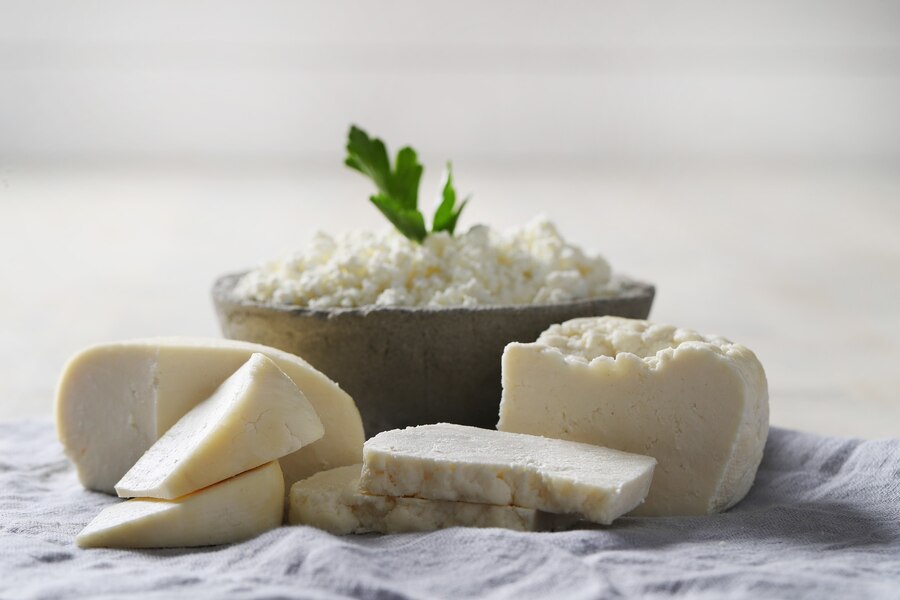Ricotta cheese is a beloved ingredient in the culinary world, known for its creamy texture and mild flavor. Originating from Italy, this cheese plays a key role in many traditional dishes, but its uses go far beyond that. Whether you’re cooking a savory dinner or preparing a sweet dessert, ricotta cheese can elevate your meals with its unique taste and versatility.
But what exactly does ricotta cheese taste like? How does it differ from other cheeses, and how can you use it in your everyday cooking? This comprehensive guide will walk you through everything you need to know about ricotta cheese its flavor profile, texture, nutritional benefits, and a wide variety of uses that will inspire your culinary creativity.
What is Ricotta Cheese ?
Before diving into the flavor, it’s essential to understand what ricotta cheese is. The name “ricotta” comes from the Italian word for “recooked,” which references the way this cheese is traditionally made. Unlike most cheeses that are made from curds, ricotta is made from the whey left over during the production of other cheeses like mozzarella and provolone.
To make ricotta, whey is reheated to form small curds, which are then strained. The result is a soft, creamy cheese that is lighter and fluffier than many other cheeses. Traditionally, ricotta is made from cow’s milk, but it can also be crafted from sheep, goat, or buffalo milk, each bringing a slightly different flavor and texture.
Fresh ricotta is often preferred for its superior quality, but it’s widely available in both fresh and processed forms in stores.
What Does Ricotta Cheese Taste Like ?
The defining feature of ricotta cheese is its mild and slightly sweet flavor. It’s not as tangy or sharp as cheeses like cheddar or feta, making it ideal for pairing with a wide range of ingredients. The flavor of ricotta can vary slightly based on the type of milk used to make it.
Here’s a breakdown of how the taste can differ:
- Cow’s Milk Ricotta: The most common form, cow’s milk ricotta is known for its mild, creamy, and subtly sweet flavor. It’s soft and neutral, making it perfect for both sweet and savory dishes.
- Sheep’s Milk Ricotta: This variety has a slightly nuttier and richer taste than cow’s milk ricotta. It’s creamier and has a fuller flavor, which makes it a great choice for savory dishes.
- Goat’s Milk Ricotta: Known for its tangier taste, goat’s milk ricotta brings a bit more earthiness to dishes. It’s slightly sharper but still retains a smooth and creamy texture.
- Buffalo’s Milk Ricotta: The richest of the bunch, buffalo milk ricotta has a full-bodied flavor and is often creamier than other types. It’s less common but highly prized for its depth of taste.
Despite these slight differences, ricotta cheese is always characterized by its fresh, clean flavor, which makes it a great base for countless recipes.
Texture of Ricotta Cheese.
The texture of ricotta is just as important as its flavor. It’s known for being light, fluffy, and slightly grainy, though not in an unpleasant way. The fine curds give it a distinctive texture that works well in everything from pasta fillings to desserts.
Unlike smoother cheeses like mascarpone or cream cheese, ricotta has a slightly grainy consistency, which adds to its appeal in dishes where a bit of texture is needed. Whether you’re spreading it on toast or mixing it into a batter, ricotta provides a satisfying mouthfeel that enhances both sweet and savory recipes.
How Does Ricotta Compare to Other Cheeses ?

When comparing ricotta cheese to other cheeses, its unique characteristics and taste really shine. Here’s how it stacks up against other common cheeses:
Ricotta vs. Cottage Cheese.
While ricotta and cottage cheese might seem similar at first glance due to their white color and soft texture, there are key differences:
- Texture: Ricotta is finer and creamier than cottage cheese, which has larger curds and a chunkier texture.
- Flavor: Cottage cheese tends to be more savory and salty, whereas ricotta is subtly sweet.
Because of these differences, ricotta is more versatile in sweet dishes compared to cottage cheese, which is primarily used in savory applications.
Ricotta vs. Mascarpone.
Mascarpone is another soft Italian cheese often compared to ricotta, but there are notable differences:
- Texture: Mascarpone is much richer and smoother than ricotta, with a buttery, almost spreadable consistency.
- Flavor: Mascarpone is slightly tangier and richer due to its high fat content, while ricotta is lighter and sweeter.
Mascarpone is more common in desserts like tiramisu, while ricotta shines in dishes where a lighter, airier texture is desired.
Ricotta vs. Cream Cheese.
Cream cheese is another soft cheese that shares some similarities with ricotta, but again, there are clear distinctions:
- Texture: Cream cheese is dense and smooth, unlike ricotta, which is fluffier and more grainy.
- Flavor: Cream cheese has a tangy, savory taste, while ricotta remains sweet and mild.
For recipes that need a lighter touch, ricotta is often the better choice.
How to Use Ricotta Cheese in Cooking ?
One of the greatest things about ricotta cheese is its versatility. It works equally well in sweet and savory dishes, making it a staple ingredient in many kitchens. Here are some popular ways to use ricotta in your cooking:
Savory Dishes with Ricotta Cheese.
Ricotta is a key ingredient in many traditional Italian savory dishes, but its uses go beyond pasta.
- Lasagna: One of the most classic uses for ricotta cheese, lasagna layers this soft cheese between pasta, sauce, and meat or vegetables. Its creamy texture provides a nice balance to the richness of the other ingredients.
- Stuffed Shells: Large pasta shells are often filled with a mixture of ricotta, spinach, and herbs before being baked with marinara sauce. The result is a creamy, satisfying dish that’s perfect for weeknight dinners or special occasions.
- Ricotta Gnocchi: A softer, fluffier alternative to traditional potato gnocchi, ricotta gnocchi melts in your mouth and pairs well with light sauces.
- Ricotta Pizza: Adding dollops of ricotta to a pizza can elevate the dish by providing a creamy contrast to the more intense flavors of tomato sauce and mozzarella.
Sweet Dishes with Ricotta Cheese.
Ricotta’s mild sweetness also makes it ideal for a variety of desserts.
- Ricotta Cheesecake: Lighter and fluffier than traditional cheesecakes made with cream cheese, ricotta cheesecake offers a deliciously smooth texture that melts in your mouth.
- Cannoli: Perhaps the most famous dessert made with ricotta, cannoli consists of crispy pastry shells filled with a sweet ricotta mixture. It’s often flavored with vanilla, chocolate chips, or citrus zest.
- Ricotta Pancakes: Adding ricotta to pancake batter results in extra fluffy pancakes that are slightly sweet and perfect for brunch. They pair well with fresh fruit and a drizzle of honey.
- Ricotta with Honey and Fruit: For a simple yet elegant dessert, try drizzling honey over a bowl of ricotta and topping it with fresh fruit, such as berries, figs, or peaches.
Ricotta as a Spread or Dip.
In addition to being used in cooked dishes, ricotta can be enjoyed raw as a spread or dip.
- On Toast: Spread ricotta on a slice of toasted bread and top with olive oil, herbs, or honey for a delicious snack or breakfast.
- As a Dip: Mix ricotta with lemon juice, garlic, and herbs to create a creamy dip for vegetables or crackers.
Health Benefits of Ricotta Cheese.
Not only is ricotta delicious, but it also offers several health benefits. Here are some reasons to add ricotta to your diet:
High in Protein.
Ricotta cheese is a great source of protein, especially because it’s made from whey, a high-quality protein. Protein is essential for muscle repair and overall body function, making ricotta a healthy addition to meals for those looking to increase their protein intake.
Low in Fat (Depending on the Type).
While full-fat ricotta is deliciously creamy, there are also low-fat and fat-free versions available. These lighter varieties retain the cheese’s creamy texture but with fewer calories and less fat, making them ideal for those watching their calorie intake.
Rich in Calcium and Vitamins.
Like most dairy products, ricotta cheese is an excellent source of calcium, which is crucial for bone health. It also contains other essential nutrients, including vitamins A and B12, which help maintain healthy vision and energy levels.
If you’re looking for a cheese that’s nutritious as well as delicious, ricotta is a great choice.
How to Make Ricotta Cheese at Home ?
While ricotta is widely available at grocery stores, you can also make it at home with just a few simple ingredients. Homemade ricotta tends to be creamier and fresher than store-bought versions, making it a great option for those who love cooking from scratch.
Ingredients:
- 4 cups whole milk
- 1 cup heavy cream (optional)
- 3 tablespoons lemon juice or white vinegar
- A pinch of salt
Instructions:
- Heat the Milk: Pour the milk and cream into a large pot and heat over medium-high heat until it reaches about 200°F, just before boiling.
- Add Acid: Remove the pot from heat and stir in the lemon juice or vinegar. Let it sit for 5-10 minutes as curds begin to form.
- Strain the Curds: Line a colander with cheesecloth and pour the mixture through it. Let the curds drain for 10-60 minutes, depending on how creamy you want your ricotta to be.
- Store and Serve: Transfer the strained ricotta to a container and refrigerate. It will keep for up to five days.
Making your own ricotta allows you to enjoy its freshest form, whether you’re using it in a savory pasta dish or a sweet dessert.
FAQs.
Is Ricotta Cheese Sweet taste or Savory ?
Ricotta cheese is generally mild and slightly sweet, but it can be used in both sweet and savory dishes. Its neutral flavor makes it an excellent base for a variety of recipes.
Can You Eat Ricotta Cheese Raw ?
Yes! Ricotta is safe to eat raw and is often enjoyed on its own, spread on toast, or mixed with other ingredients for dips and desserts.
What’s the Difference Between Ricotta and Cottage Cheese ?
While both are soft, white cheeses, ricotta has a finer texture and a sweeter flavor, whereas cottage cheese is chunkier and more savory.
Can You Freeze Ricotta Cheese ?
Yes, but freezing can affect the texture of ricotta. It may become more grainy when thawed, so it’s best to use frozen ricotta in cooked dishes.
What Are Some Substitutes for Ricotta Cheese ?
If you don’t have ricotta on hand, you can use substitutes like cottage cheese, mascarpone, or even cream cheese, depending on the dish. Keep in mind that these alternatives will slightly alter the texture and flavor of the recipe.
Conclusion.
Ricotta cheese is a versatile, nutritious ingredient that adds a creamy touch to a wide range of dishes. Whether you’re using it in lasagna, baking it into a cheesecake, or simply spreading it on toast, ricotta’s mild, slightly sweet flavor and light, fluffy texture make it an excellent addition to any meal.
With its health benefits, including high protein and calcium content, ricotta is a delicious and nutritious option for those looking to enjoy their meals while maintaining a balanced diet. Whether you buy it from the store or make your own at home, ricotta cheese is sure to enhance your cooking in ways both simple and gourmet.
While describing how ricotta pairs with different ingredients, such as for toast or stuffing pasta, you can link to articles about complementary flavors. For instance, the best bread for French toast could be useful when recommending bread types that go well with ricotta in savory and sweet dishes.

